Enhancing Effective Teamwork in Healthcare: Assessment & Strategies
VerifiedAdded on 2023/06/13
|15
|4883
|73
Report
AI Summary
This report critically reviews the literature on team effectiveness in healthcare, discussing issues that arise within teams and strategies for successful resolution. It assesses two teams: a regular work team and a quality improvement project team, using evidence-based criteria. The report reflects on the author's role as a team member and suggests ways to enhance team effectiveness, supported by literature references. Key areas explored include the impact of patient load on team performance, the importance of cooperative teamwork, and the role of team leaders in fostering unity and achieving common goals. The report also highlights the significance of risk management, communication, and continuous training in improving team dynamics and overall healthcare outcomes. The document is available on Desklib, a platform offering study tools and resources for students.
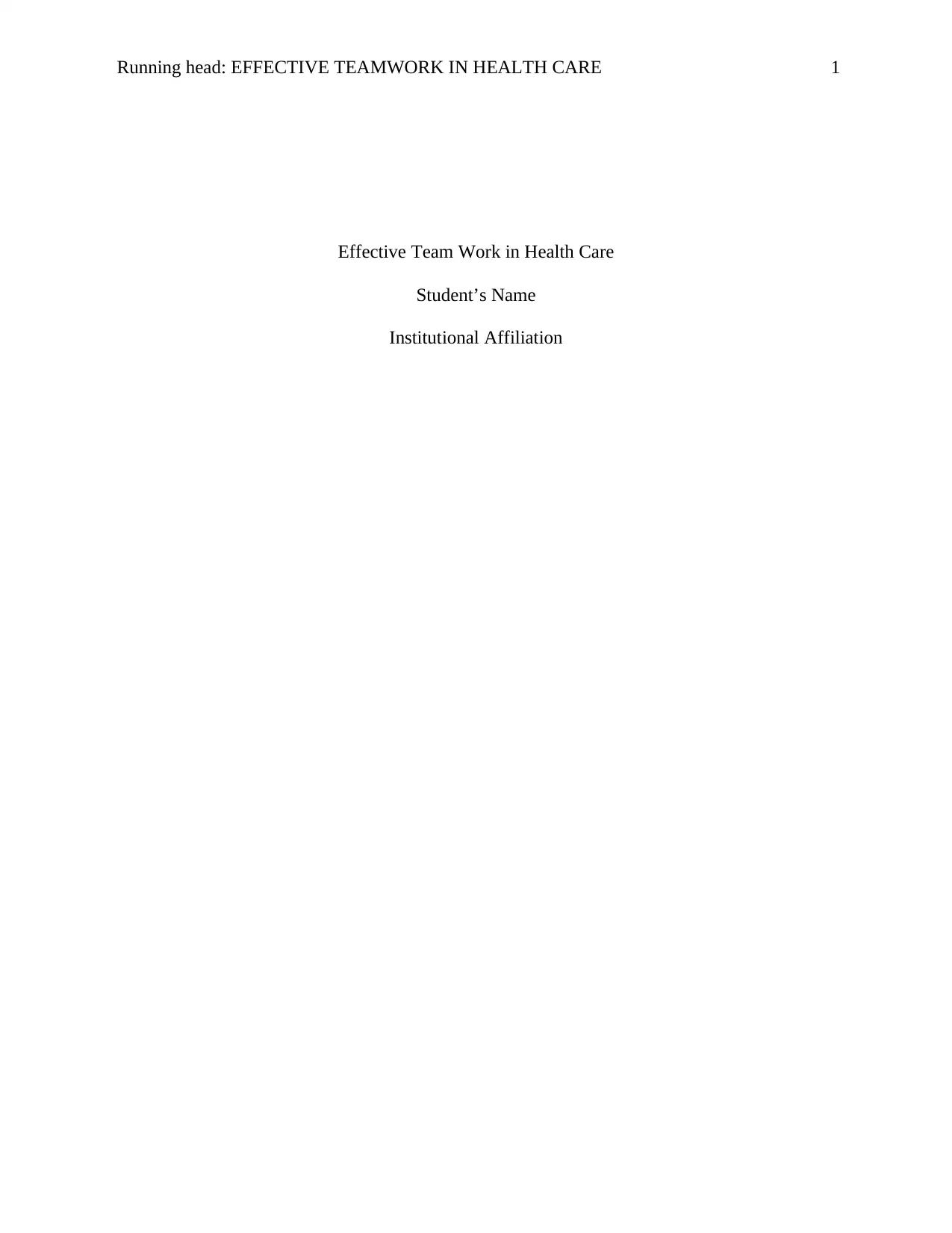
Running head: EFFECTIVE TEAMWORK IN HEALTH CARE 1
Effective Team Work in Health Care
Student’s Name
Institutional Affiliation
Effective Team Work in Health Care
Student’s Name
Institutional Affiliation
Paraphrase This Document
Need a fresh take? Get an instant paraphrase of this document with our AI Paraphraser
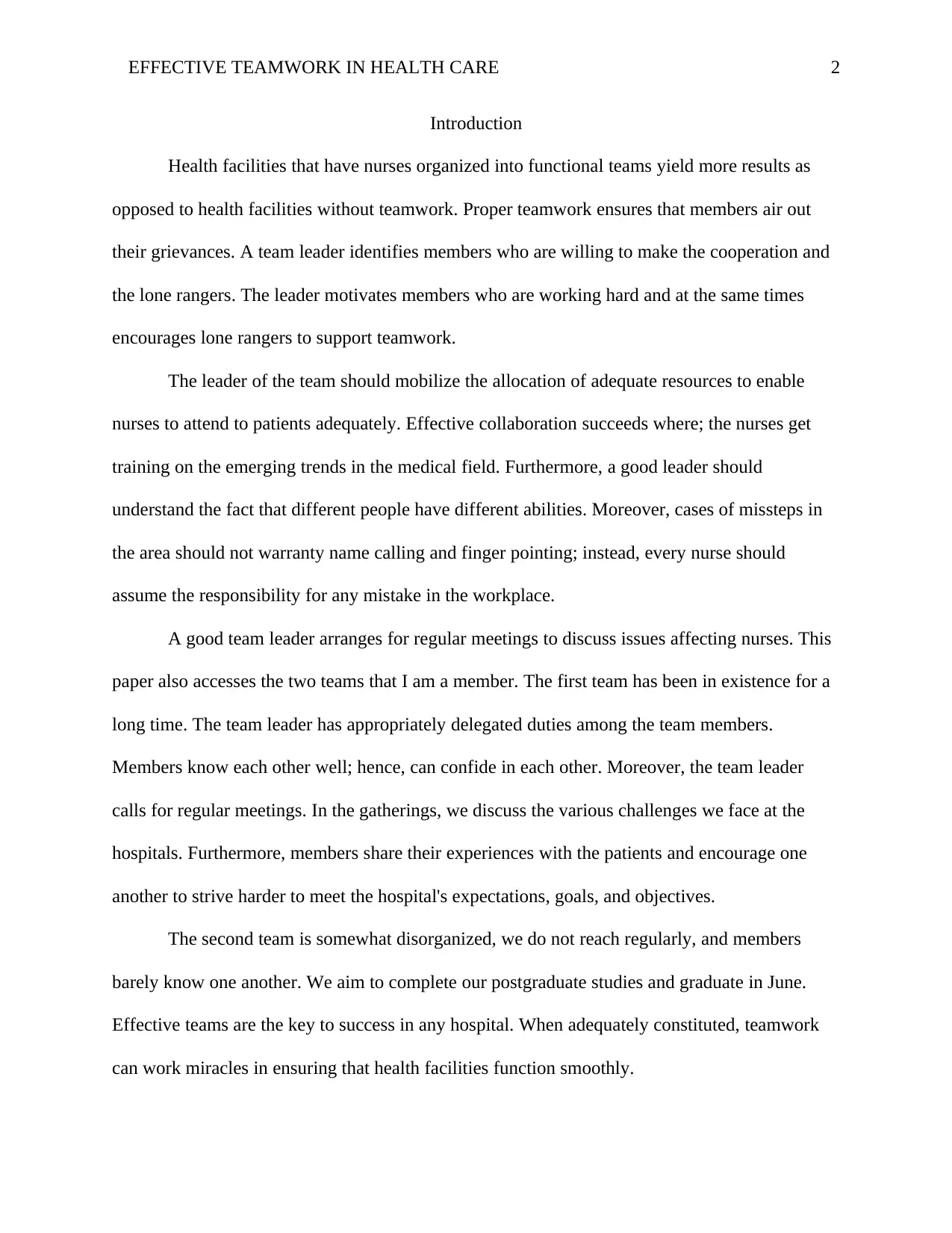
EFFECTIVE TEAMWORK IN HEALTH CARE 2
Introduction
Health facilities that have nurses organized into functional teams yield more results as
opposed to health facilities without teamwork. Proper teamwork ensures that members air out
their grievances. A team leader identifies members who are willing to make the cooperation and
the lone rangers. The leader motivates members who are working hard and at the same times
encourages lone rangers to support teamwork.
The leader of the team should mobilize the allocation of adequate resources to enable
nurses to attend to patients adequately. Effective collaboration succeeds where; the nurses get
training on the emerging trends in the medical field. Furthermore, a good leader should
understand the fact that different people have different abilities. Moreover, cases of missteps in
the area should not warranty name calling and finger pointing; instead, every nurse should
assume the responsibility for any mistake in the workplace.
A good team leader arranges for regular meetings to discuss issues affecting nurses. This
paper also accesses the two teams that I am a member. The first team has been in existence for a
long time. The team leader has appropriately delegated duties among the team members.
Members know each other well; hence, can confide in each other. Moreover, the team leader
calls for regular meetings. In the gatherings, we discuss the various challenges we face at the
hospitals. Furthermore, members share their experiences with the patients and encourage one
another to strive harder to meet the hospital's expectations, goals, and objectives.
The second team is somewhat disorganized, we do not reach regularly, and members
barely know one another. We aim to complete our postgraduate studies and graduate in June.
Effective teams are the key to success in any hospital. When adequately constituted, teamwork
can work miracles in ensuring that health facilities function smoothly.
Introduction
Health facilities that have nurses organized into functional teams yield more results as
opposed to health facilities without teamwork. Proper teamwork ensures that members air out
their grievances. A team leader identifies members who are willing to make the cooperation and
the lone rangers. The leader motivates members who are working hard and at the same times
encourages lone rangers to support teamwork.
The leader of the team should mobilize the allocation of adequate resources to enable
nurses to attend to patients adequately. Effective collaboration succeeds where; the nurses get
training on the emerging trends in the medical field. Furthermore, a good leader should
understand the fact that different people have different abilities. Moreover, cases of missteps in
the area should not warranty name calling and finger pointing; instead, every nurse should
assume the responsibility for any mistake in the workplace.
A good team leader arranges for regular meetings to discuss issues affecting nurses. This
paper also accesses the two teams that I am a member. The first team has been in existence for a
long time. The team leader has appropriately delegated duties among the team members.
Members know each other well; hence, can confide in each other. Moreover, the team leader
calls for regular meetings. In the gatherings, we discuss the various challenges we face at the
hospitals. Furthermore, members share their experiences with the patients and encourage one
another to strive harder to meet the hospital's expectations, goals, and objectives.
The second team is somewhat disorganized, we do not reach regularly, and members
barely know one another. We aim to complete our postgraduate studies and graduate in June.
Effective teams are the key to success in any hospital. When adequately constituted, teamwork
can work miracles in ensuring that health facilities function smoothly.
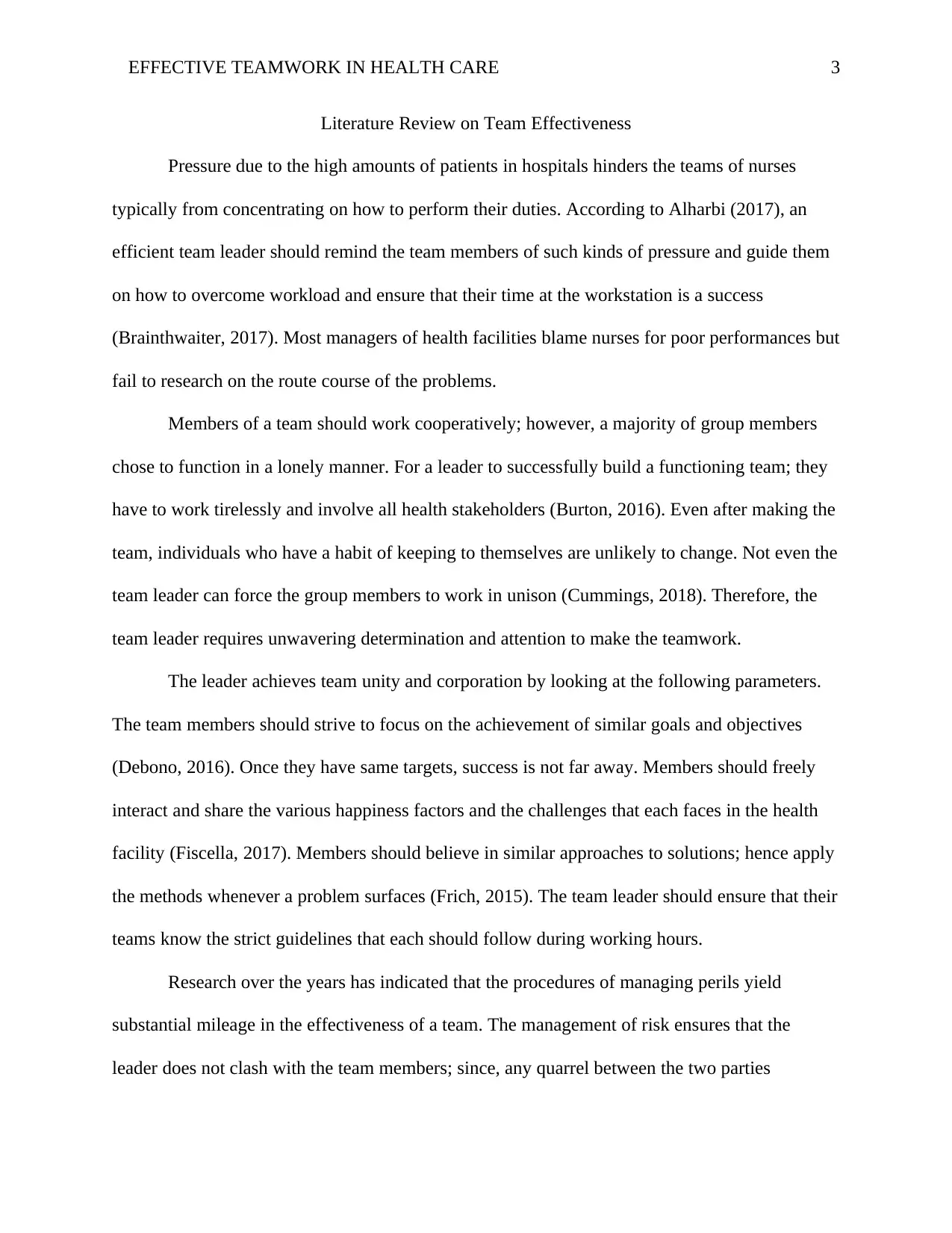
EFFECTIVE TEAMWORK IN HEALTH CARE 3
Literature Review on Team Effectiveness
Pressure due to the high amounts of patients in hospitals hinders the teams of nurses
typically from concentrating on how to perform their duties. According to Alharbi (2017), an
efficient team leader should remind the team members of such kinds of pressure and guide them
on how to overcome workload and ensure that their time at the workstation is a success
(Brainthwaiter, 2017). Most managers of health facilities blame nurses for poor performances but
fail to research on the route course of the problems.
Members of a team should work cooperatively; however, a majority of group members
chose to function in a lonely manner. For a leader to successfully build a functioning team; they
have to work tirelessly and involve all health stakeholders (Burton, 2016). Even after making the
team, individuals who have a habit of keeping to themselves are unlikely to change. Not even the
team leader can force the group members to work in unison (Cummings, 2018). Therefore, the
team leader requires unwavering determination and attention to make the teamwork.
The leader achieves team unity and corporation by looking at the following parameters.
The team members should strive to focus on the achievement of similar goals and objectives
(Debono, 2016). Once they have same targets, success is not far away. Members should freely
interact and share the various happiness factors and the challenges that each faces in the health
facility (Fiscella, 2017). Members should believe in similar approaches to solutions; hence apply
the methods whenever a problem surfaces (Frich, 2015). The team leader should ensure that their
teams know the strict guidelines that each should follow during working hours.
Research over the years has indicated that the procedures of managing perils yield
substantial mileage in the effectiveness of a team. The management of risk ensures that the
leader does not clash with the team members; since, any quarrel between the two parties
Literature Review on Team Effectiveness
Pressure due to the high amounts of patients in hospitals hinders the teams of nurses
typically from concentrating on how to perform their duties. According to Alharbi (2017), an
efficient team leader should remind the team members of such kinds of pressure and guide them
on how to overcome workload and ensure that their time at the workstation is a success
(Brainthwaiter, 2017). Most managers of health facilities blame nurses for poor performances but
fail to research on the route course of the problems.
Members of a team should work cooperatively; however, a majority of group members
chose to function in a lonely manner. For a leader to successfully build a functioning team; they
have to work tirelessly and involve all health stakeholders (Burton, 2016). Even after making the
team, individuals who have a habit of keeping to themselves are unlikely to change. Not even the
team leader can force the group members to work in unison (Cummings, 2018). Therefore, the
team leader requires unwavering determination and attention to make the teamwork.
The leader achieves team unity and corporation by looking at the following parameters.
The team members should strive to focus on the achievement of similar goals and objectives
(Debono, 2016). Once they have same targets, success is not far away. Members should freely
interact and share the various happiness factors and the challenges that each faces in the health
facility (Fiscella, 2017). Members should believe in similar approaches to solutions; hence apply
the methods whenever a problem surfaces (Frich, 2015). The team leader should ensure that their
teams know the strict guidelines that each should follow during working hours.
Research over the years has indicated that the procedures of managing perils yield
substantial mileage in the effectiveness of a team. The management of risk ensures that the
leader does not clash with the team members; since, any quarrel between the two parties
⊘ This is a preview!⊘
Do you want full access?
Subscribe today to unlock all pages.

Trusted by 1+ million students worldwide
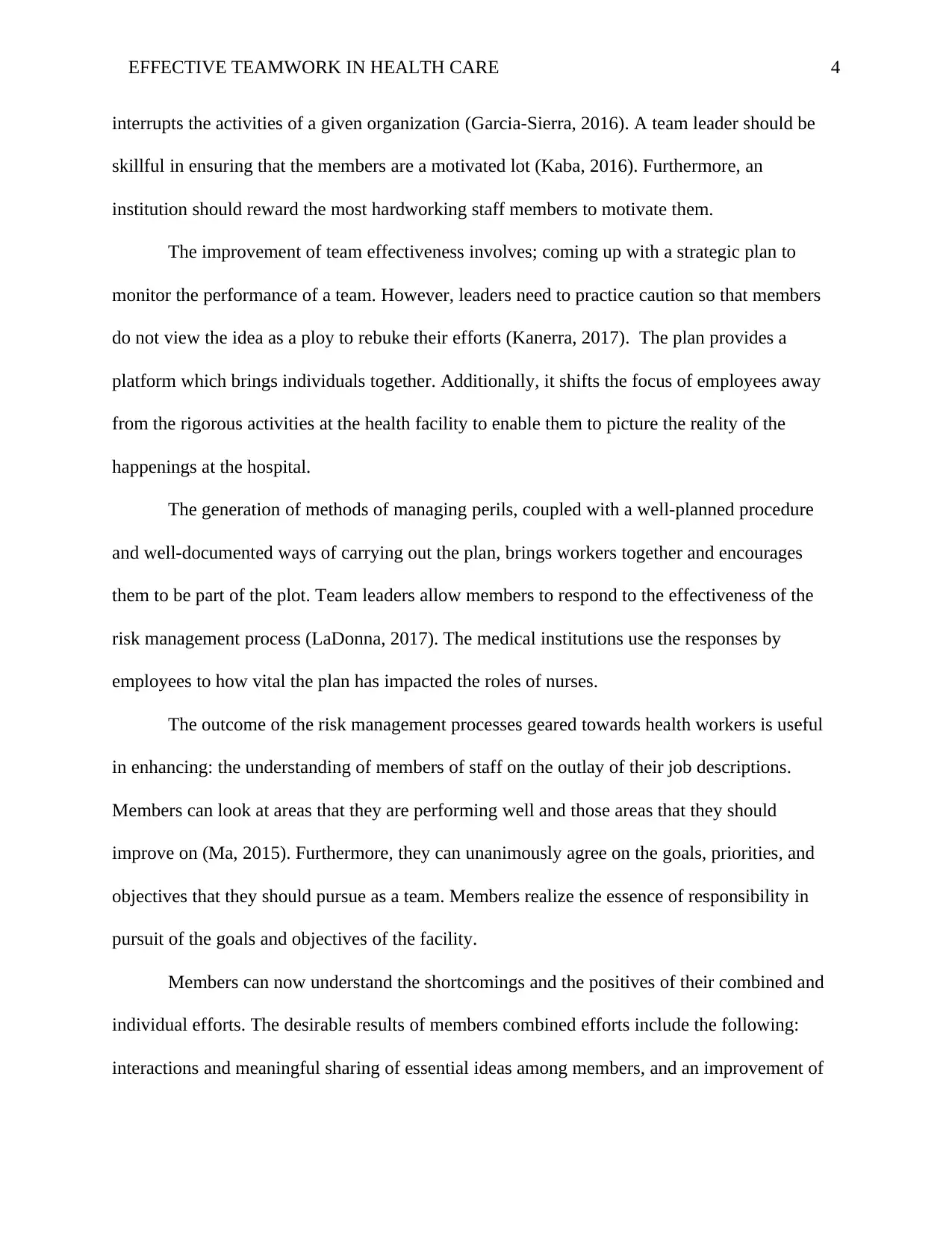
EFFECTIVE TEAMWORK IN HEALTH CARE 4
interrupts the activities of a given organization (Garcia-Sierra, 2016). A team leader should be
skillful in ensuring that the members are a motivated lot (Kaba, 2016). Furthermore, an
institution should reward the most hardworking staff members to motivate them.
The improvement of team effectiveness involves; coming up with a strategic plan to
monitor the performance of a team. However, leaders need to practice caution so that members
do not view the idea as a ploy to rebuke their efforts (Kanerra, 2017). The plan provides a
platform which brings individuals together. Additionally, it shifts the focus of employees away
from the rigorous activities at the health facility to enable them to picture the reality of the
happenings at the hospital.
The generation of methods of managing perils, coupled with a well-planned procedure
and well-documented ways of carrying out the plan, brings workers together and encourages
them to be part of the plot. Team leaders allow members to respond to the effectiveness of the
risk management process (LaDonna, 2017). The medical institutions use the responses by
employees to how vital the plan has impacted the roles of nurses.
The outcome of the risk management processes geared towards health workers is useful
in enhancing: the understanding of members of staff on the outlay of their job descriptions.
Members can look at areas that they are performing well and those areas that they should
improve on (Ma, 2015). Furthermore, they can unanimously agree on the goals, priorities, and
objectives that they should pursue as a team. Members realize the essence of responsibility in
pursuit of the goals and objectives of the facility.
Members can now understand the shortcomings and the positives of their combined and
individual efforts. The desirable results of members combined efforts include the following:
interactions and meaningful sharing of essential ideas among members, and an improvement of
interrupts the activities of a given organization (Garcia-Sierra, 2016). A team leader should be
skillful in ensuring that the members are a motivated lot (Kaba, 2016). Furthermore, an
institution should reward the most hardworking staff members to motivate them.
The improvement of team effectiveness involves; coming up with a strategic plan to
monitor the performance of a team. However, leaders need to practice caution so that members
do not view the idea as a ploy to rebuke their efforts (Kanerra, 2017). The plan provides a
platform which brings individuals together. Additionally, it shifts the focus of employees away
from the rigorous activities at the health facility to enable them to picture the reality of the
happenings at the hospital.
The generation of methods of managing perils, coupled with a well-planned procedure
and well-documented ways of carrying out the plan, brings workers together and encourages
them to be part of the plot. Team leaders allow members to respond to the effectiveness of the
risk management process (LaDonna, 2017). The medical institutions use the responses by
employees to how vital the plan has impacted the roles of nurses.
The outcome of the risk management processes geared towards health workers is useful
in enhancing: the understanding of members of staff on the outlay of their job descriptions.
Members can look at areas that they are performing well and those areas that they should
improve on (Ma, 2015). Furthermore, they can unanimously agree on the goals, priorities, and
objectives that they should pursue as a team. Members realize the essence of responsibility in
pursuit of the goals and objectives of the facility.
Members can now understand the shortcomings and the positives of their combined and
individual efforts. The desirable results of members combined efforts include the following:
interactions and meaningful sharing of essential ideas among members, and an improvement of
Paraphrase This Document
Need a fresh take? Get an instant paraphrase of this document with our AI Paraphraser
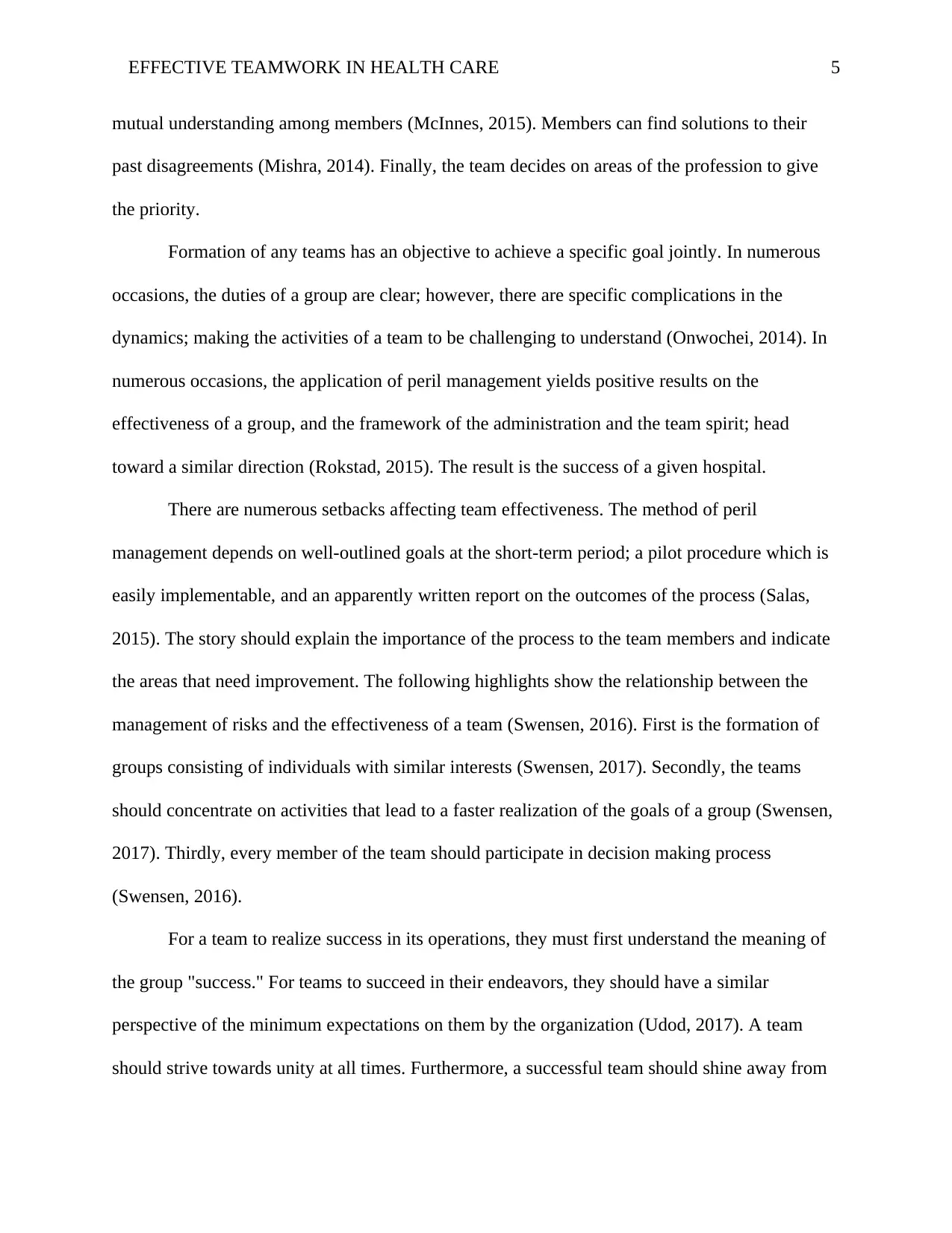
EFFECTIVE TEAMWORK IN HEALTH CARE 5
mutual understanding among members (McInnes, 2015). Members can find solutions to their
past disagreements (Mishra, 2014). Finally, the team decides on areas of the profession to give
the priority.
Formation of any teams has an objective to achieve a specific goal jointly. In numerous
occasions, the duties of a group are clear; however, there are specific complications in the
dynamics; making the activities of a team to be challenging to understand (Onwochei, 2014). In
numerous occasions, the application of peril management yields positive results on the
effectiveness of a group, and the framework of the administration and the team spirit; head
toward a similar direction (Rokstad, 2015). The result is the success of a given hospital.
There are numerous setbacks affecting team effectiveness. The method of peril
management depends on well-outlined goals at the short-term period; a pilot procedure which is
easily implementable, and an apparently written report on the outcomes of the process (Salas,
2015). The story should explain the importance of the process to the team members and indicate
the areas that need improvement. The following highlights show the relationship between the
management of risks and the effectiveness of a team (Swensen, 2016). First is the formation of
groups consisting of individuals with similar interests (Swensen, 2017). Secondly, the teams
should concentrate on activities that lead to a faster realization of the goals of a group (Swensen,
2017). Thirdly, every member of the team should participate in decision making process
(Swensen, 2016).
For a team to realize success in its operations, they must first understand the meaning of
the group "success." For teams to succeed in their endeavors, they should have a similar
perspective of the minimum expectations on them by the organization (Udod, 2017). A team
should strive towards unity at all times. Furthermore, a successful team should shine away from
mutual understanding among members (McInnes, 2015). Members can find solutions to their
past disagreements (Mishra, 2014). Finally, the team decides on areas of the profession to give
the priority.
Formation of any teams has an objective to achieve a specific goal jointly. In numerous
occasions, the duties of a group are clear; however, there are specific complications in the
dynamics; making the activities of a team to be challenging to understand (Onwochei, 2014). In
numerous occasions, the application of peril management yields positive results on the
effectiveness of a group, and the framework of the administration and the team spirit; head
toward a similar direction (Rokstad, 2015). The result is the success of a given hospital.
There are numerous setbacks affecting team effectiveness. The method of peril
management depends on well-outlined goals at the short-term period; a pilot procedure which is
easily implementable, and an apparently written report on the outcomes of the process (Salas,
2015). The story should explain the importance of the process to the team members and indicate
the areas that need improvement. The following highlights show the relationship between the
management of risks and the effectiveness of a team (Swensen, 2016). First is the formation of
groups consisting of individuals with similar interests (Swensen, 2017). Secondly, the teams
should concentrate on activities that lead to a faster realization of the goals of a group (Swensen,
2017). Thirdly, every member of the team should participate in decision making process
(Swensen, 2016).
For a team to realize success in its operations, they must first understand the meaning of
the group "success." For teams to succeed in their endeavors, they should have a similar
perspective of the minimum expectations on them by the organization (Udod, 2017). A team
should strive towards unity at all times. Furthermore, a successful team should shine away from
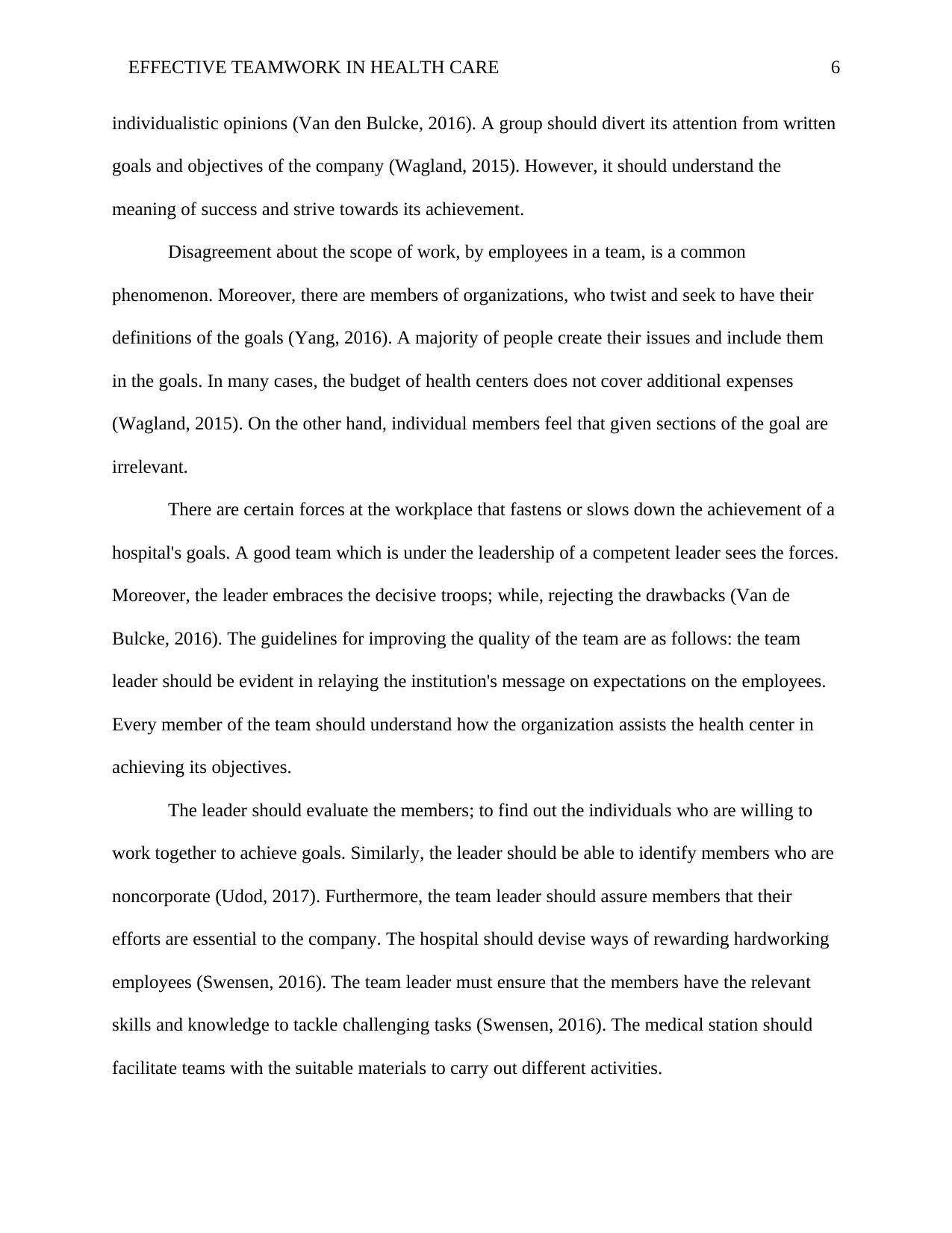
EFFECTIVE TEAMWORK IN HEALTH CARE 6
individualistic opinions (Van den Bulcke, 2016). A group should divert its attention from written
goals and objectives of the company (Wagland, 2015). However, it should understand the
meaning of success and strive towards its achievement.
Disagreement about the scope of work, by employees in a team, is a common
phenomenon. Moreover, there are members of organizations, who twist and seek to have their
definitions of the goals (Yang, 2016). A majority of people create their issues and include them
in the goals. In many cases, the budget of health centers does not cover additional expenses
(Wagland, 2015). On the other hand, individual members feel that given sections of the goal are
irrelevant.
There are certain forces at the workplace that fastens or slows down the achievement of a
hospital's goals. A good team which is under the leadership of a competent leader sees the forces.
Moreover, the leader embraces the decisive troops; while, rejecting the drawbacks (Van de
Bulcke, 2016). The guidelines for improving the quality of the team are as follows: the team
leader should be evident in relaying the institution's message on expectations on the employees.
Every member of the team should understand how the organization assists the health center in
achieving its objectives.
The leader should evaluate the members; to find out the individuals who are willing to
work together to achieve goals. Similarly, the leader should be able to identify members who are
noncorporate (Udod, 2017). Furthermore, the team leader should assure members that their
efforts are essential to the company. The hospital should devise ways of rewarding hardworking
employees (Swensen, 2016). The team leader must ensure that the members have the relevant
skills and knowledge to tackle challenging tasks (Swensen, 2016). The medical station should
facilitate teams with the suitable materials to carry out different activities.
individualistic opinions (Van den Bulcke, 2016). A group should divert its attention from written
goals and objectives of the company (Wagland, 2015). However, it should understand the
meaning of success and strive towards its achievement.
Disagreement about the scope of work, by employees in a team, is a common
phenomenon. Moreover, there are members of organizations, who twist and seek to have their
definitions of the goals (Yang, 2016). A majority of people create their issues and include them
in the goals. In many cases, the budget of health centers does not cover additional expenses
(Wagland, 2015). On the other hand, individual members feel that given sections of the goal are
irrelevant.
There are certain forces at the workplace that fastens or slows down the achievement of a
hospital's goals. A good team which is under the leadership of a competent leader sees the forces.
Moreover, the leader embraces the decisive troops; while, rejecting the drawbacks (Van de
Bulcke, 2016). The guidelines for improving the quality of the team are as follows: the team
leader should be evident in relaying the institution's message on expectations on the employees.
Every member of the team should understand how the organization assists the health center in
achieving its objectives.
The leader should evaluate the members; to find out the individuals who are willing to
work together to achieve goals. Similarly, the leader should be able to identify members who are
noncorporate (Udod, 2017). Furthermore, the team leader should assure members that their
efforts are essential to the company. The hospital should devise ways of rewarding hardworking
employees (Swensen, 2016). The team leader must ensure that the members have the relevant
skills and knowledge to tackle challenging tasks (Swensen, 2016). The medical station should
facilitate teams with the suitable materials to carry out different activities.
⊘ This is a preview!⊘
Do you want full access?
Subscribe today to unlock all pages.

Trusted by 1+ million students worldwide
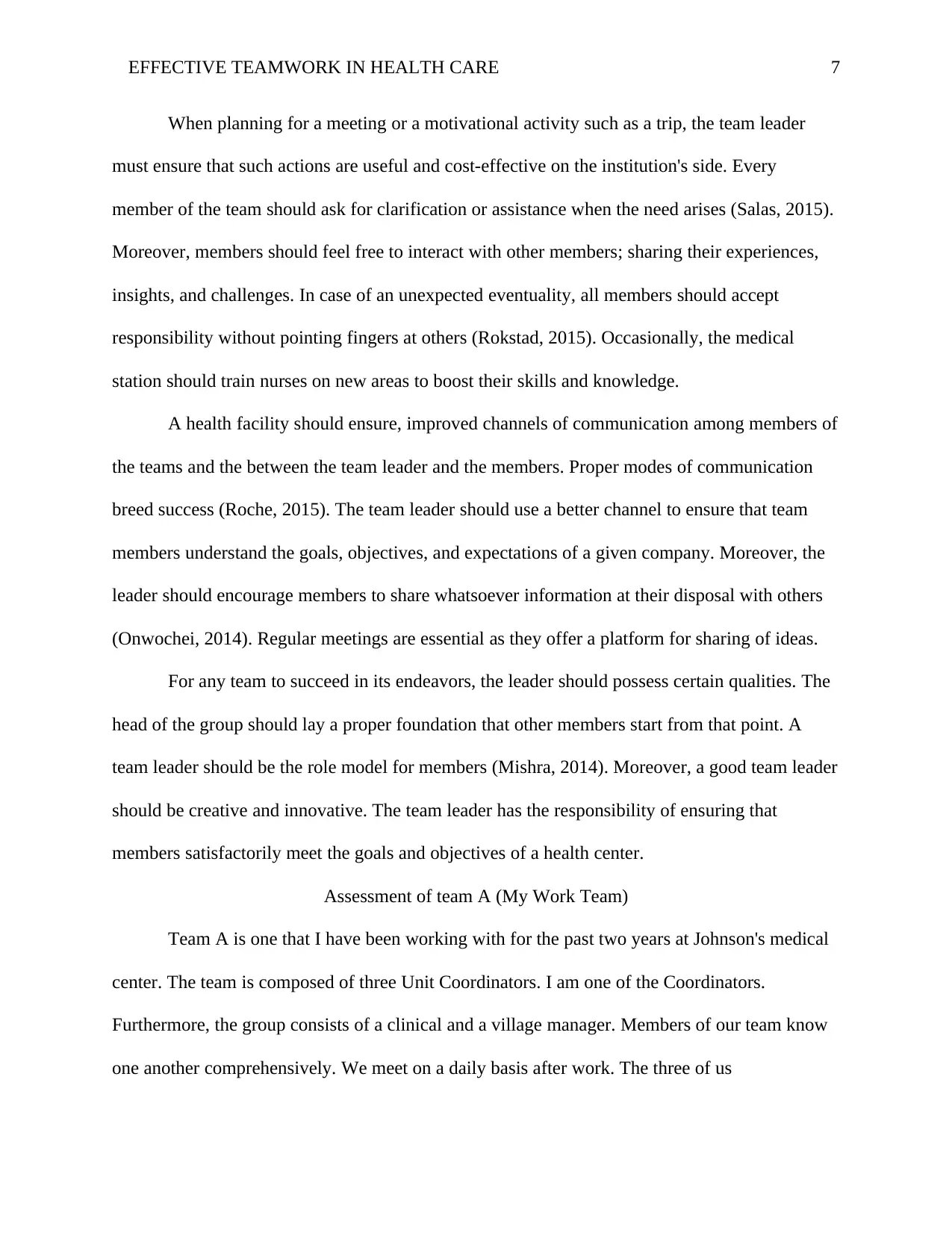
EFFECTIVE TEAMWORK IN HEALTH CARE 7
When planning for a meeting or a motivational activity such as a trip, the team leader
must ensure that such actions are useful and cost-effective on the institution's side. Every
member of the team should ask for clarification or assistance when the need arises (Salas, 2015).
Moreover, members should feel free to interact with other members; sharing their experiences,
insights, and challenges. In case of an unexpected eventuality, all members should accept
responsibility without pointing fingers at others (Rokstad, 2015). Occasionally, the medical
station should train nurses on new areas to boost their skills and knowledge.
A health facility should ensure, improved channels of communication among members of
the teams and the between the team leader and the members. Proper modes of communication
breed success (Roche, 2015). The team leader should use a better channel to ensure that team
members understand the goals, objectives, and expectations of a given company. Moreover, the
leader should encourage members to share whatsoever information at their disposal with others
(Onwochei, 2014). Regular meetings are essential as they offer a platform for sharing of ideas.
For any team to succeed in its endeavors, the leader should possess certain qualities. The
head of the group should lay a proper foundation that other members start from that point. A
team leader should be the role model for members (Mishra, 2014). Moreover, a good team leader
should be creative and innovative. The team leader has the responsibility of ensuring that
members satisfactorily meet the goals and objectives of a health center.
Assessment of team A (My Work Team)
Team A is one that I have been working with for the past two years at Johnson's medical
center. The team is composed of three Unit Coordinators. I am one of the Coordinators.
Furthermore, the group consists of a clinical and a village manager. Members of our team know
one another comprehensively. We meet on a daily basis after work. The three of us
When planning for a meeting or a motivational activity such as a trip, the team leader
must ensure that such actions are useful and cost-effective on the institution's side. Every
member of the team should ask for clarification or assistance when the need arises (Salas, 2015).
Moreover, members should feel free to interact with other members; sharing their experiences,
insights, and challenges. In case of an unexpected eventuality, all members should accept
responsibility without pointing fingers at others (Rokstad, 2015). Occasionally, the medical
station should train nurses on new areas to boost their skills and knowledge.
A health facility should ensure, improved channels of communication among members of
the teams and the between the team leader and the members. Proper modes of communication
breed success (Roche, 2015). The team leader should use a better channel to ensure that team
members understand the goals, objectives, and expectations of a given company. Moreover, the
leader should encourage members to share whatsoever information at their disposal with others
(Onwochei, 2014). Regular meetings are essential as they offer a platform for sharing of ideas.
For any team to succeed in its endeavors, the leader should possess certain qualities. The
head of the group should lay a proper foundation that other members start from that point. A
team leader should be the role model for members (Mishra, 2014). Moreover, a good team leader
should be creative and innovative. The team leader has the responsibility of ensuring that
members satisfactorily meet the goals and objectives of a health center.
Assessment of team A (My Work Team)
Team A is one that I have been working with for the past two years at Johnson's medical
center. The team is composed of three Unit Coordinators. I am one of the Coordinators.
Furthermore, the group consists of a clinical and a village manager. Members of our team know
one another comprehensively. We meet on a daily basis after work. The three of us
Paraphrase This Document
Need a fresh take? Get an instant paraphrase of this document with our AI Paraphraser

EFFECTIVE TEAMWORK IN HEALTH CARE 8
(Coordinators) supervise patient care. The clinical and village managers supervise staff
members, residents, relatives, and private healthcare respectively.
The fact that members of the group understand each other is an added advantage.
Individuals share experiences on their interactions with patients. We discuss various issues
including how to disclose to relatives of the death of their loved ones. Challenges that we face
are very few. Members are complaining of overwork to fit in the 24 hour economy. The ratio of
nurses to patients is 1: 5. The health facility rewards hardworking health workers twice a year.
The reward should be on a monthly basis.
Our team leader is patient individual who understands the plight of members. He expects
us to attend to more than one hundred patients in a day, which stretches our limits. The health
facility has few critical modern equipment to participate in critical conditions such as epilepsy.
In cases of clinical errors, members distance self from the mistakes and blame the individual
responsible. Members should accept joint responsibility. The hospital does carries out continuous
training to sharpen our skills on attending to patients, although not in a regular basis. Our leader
is sure of the expectations from the board members, but expects us to do more.
The few numbers of challenges that we face at the health facility have a variety of
solutions. Firstly, the team leader should lobby the management to employ more nurses (Alharbi,
2017). The hiring relives us of the workload. Therefore, we need time to deliver to the
expectations of the board of directors. The team leader should ensure that we have adequate
resources to attend to patients with special conditions. The managers should reward hardworking
nurses to motivate us. The team leader should facilitate regular training; especially in the field of
technology.
(Coordinators) supervise patient care. The clinical and village managers supervise staff
members, residents, relatives, and private healthcare respectively.
The fact that members of the group understand each other is an added advantage.
Individuals share experiences on their interactions with patients. We discuss various issues
including how to disclose to relatives of the death of their loved ones. Challenges that we face
are very few. Members are complaining of overwork to fit in the 24 hour economy. The ratio of
nurses to patients is 1: 5. The health facility rewards hardworking health workers twice a year.
The reward should be on a monthly basis.
Our team leader is patient individual who understands the plight of members. He expects
us to attend to more than one hundred patients in a day, which stretches our limits. The health
facility has few critical modern equipment to participate in critical conditions such as epilepsy.
In cases of clinical errors, members distance self from the mistakes and blame the individual
responsible. Members should accept joint responsibility. The hospital does carries out continuous
training to sharpen our skills on attending to patients, although not in a regular basis. Our leader
is sure of the expectations from the board members, but expects us to do more.
The few numbers of challenges that we face at the health facility have a variety of
solutions. Firstly, the team leader should lobby the management to employ more nurses (Alharbi,
2017). The hiring relives us of the workload. Therefore, we need time to deliver to the
expectations of the board of directors. The team leader should ensure that we have adequate
resources to attend to patients with special conditions. The managers should reward hardworking
nurses to motivate us. The team leader should facilitate regular training; especially in the field of
technology.
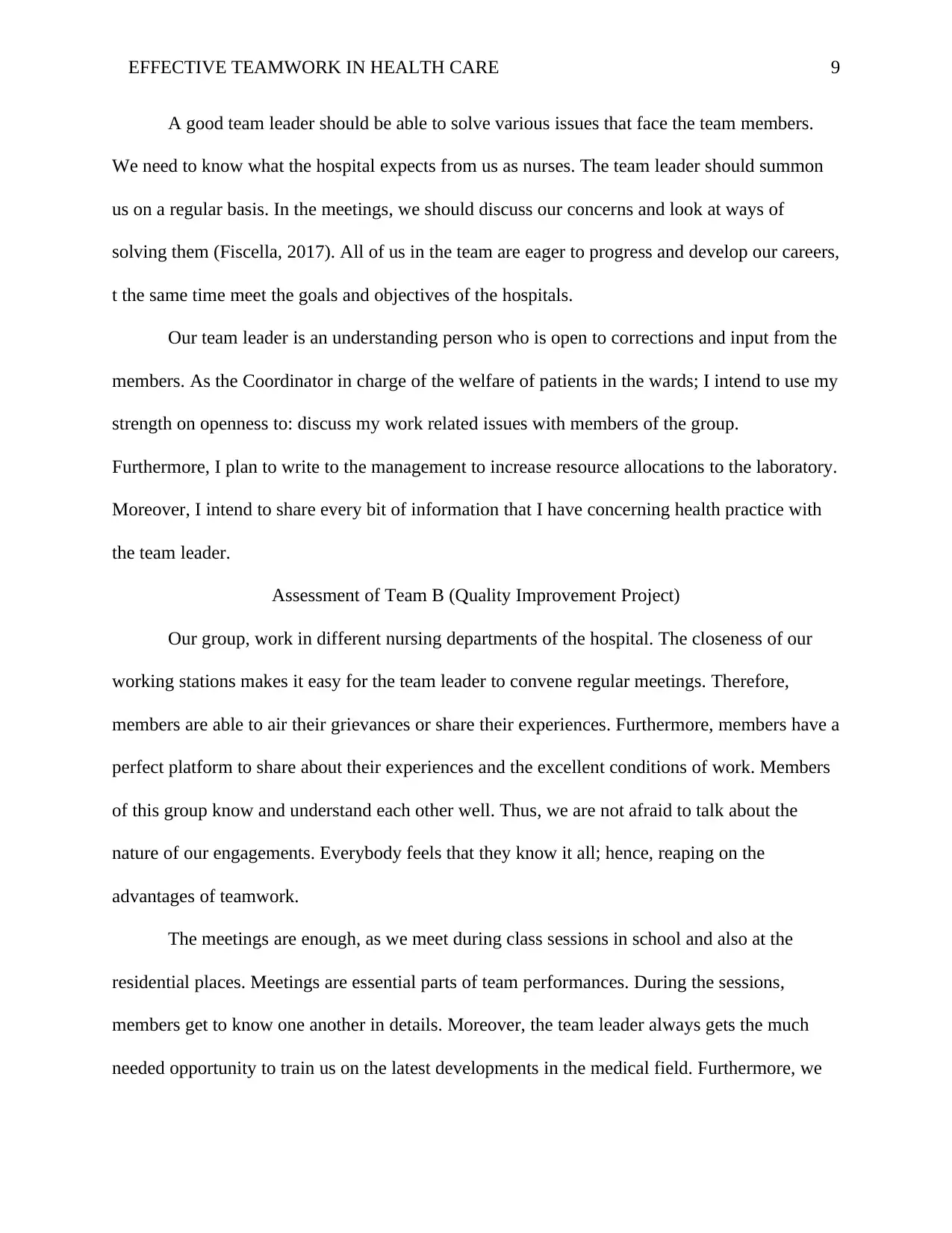
EFFECTIVE TEAMWORK IN HEALTH CARE 9
A good team leader should be able to solve various issues that face the team members.
We need to know what the hospital expects from us as nurses. The team leader should summon
us on a regular basis. In the meetings, we should discuss our concerns and look at ways of
solving them (Fiscella, 2017). All of us in the team are eager to progress and develop our careers,
t the same time meet the goals and objectives of the hospitals.
Our team leader is an understanding person who is open to corrections and input from the
members. As the Coordinator in charge of the welfare of patients in the wards; I intend to use my
strength on openness to: discuss my work related issues with members of the group.
Furthermore, I plan to write to the management to increase resource allocations to the laboratory.
Moreover, I intend to share every bit of information that I have concerning health practice with
the team leader.
Assessment of Team B (Quality Improvement Project)
Our group, work in different nursing departments of the hospital. The closeness of our
working stations makes it easy for the team leader to convene regular meetings. Therefore,
members are able to air their grievances or share their experiences. Furthermore, members have a
perfect platform to share about their experiences and the excellent conditions of work. Members
of this group know and understand each other well. Thus, we are not afraid to talk about the
nature of our engagements. Everybody feels that they know it all; hence, reaping on the
advantages of teamwork.
The meetings are enough, as we meet during class sessions in school and also at the
residential places. Meetings are essential parts of team performances. During the sessions,
members get to know one another in details. Moreover, the team leader always gets the much
needed opportunity to train us on the latest developments in the medical field. Furthermore, we
A good team leader should be able to solve various issues that face the team members.
We need to know what the hospital expects from us as nurses. The team leader should summon
us on a regular basis. In the meetings, we should discuss our concerns and look at ways of
solving them (Fiscella, 2017). All of us in the team are eager to progress and develop our careers,
t the same time meet the goals and objectives of the hospitals.
Our team leader is an understanding person who is open to corrections and input from the
members. As the Coordinator in charge of the welfare of patients in the wards; I intend to use my
strength on openness to: discuss my work related issues with members of the group.
Furthermore, I plan to write to the management to increase resource allocations to the laboratory.
Moreover, I intend to share every bit of information that I have concerning health practice with
the team leader.
Assessment of Team B (Quality Improvement Project)
Our group, work in different nursing departments of the hospital. The closeness of our
working stations makes it easy for the team leader to convene regular meetings. Therefore,
members are able to air their grievances or share their experiences. Furthermore, members have a
perfect platform to share about their experiences and the excellent conditions of work. Members
of this group know and understand each other well. Thus, we are not afraid to talk about the
nature of our engagements. Everybody feels that they know it all; hence, reaping on the
advantages of teamwork.
The meetings are enough, as we meet during class sessions in school and also at the
residential places. Meetings are essential parts of team performances. During the sessions,
members get to know one another in details. Moreover, the team leader always gets the much
needed opportunity to train us on the latest developments in the medical field. Furthermore, we
⊘ This is a preview!⊘
Do you want full access?
Subscribe today to unlock all pages.

Trusted by 1+ million students worldwide

EFFECTIVE TEAMWORK IN HEALTH CARE 10
always air our challenges and motivate one another towards the realization of the goals and
objectives of the hospitals. During meetings, the team leader normally briefs us on the health
facility expectations, goals, and objectives.
The numerous meetings are essential as we can easily access all the advantages listed
above. We formed the group just the other day but we have gained can a significant number of
benefits from the group. Our primary goal is to demonstrate the ability to identify the strengths
of the health facility. Moreover, we task ourselves with the responsibility of identifying the
strengths of the health facility. Additionally, we look at the possible challenges and ways to find
a lasting solution. Secondly, we intend to come up with a report. The health facility and the
university require the report to understand the dynamics in the health care sector. Our team
leader has explained all the necessary information to us, the list of activities that we need to do to
ensure that we successful graduate from the nursing school with good grades. We always attend
outside classroom training on reading skills. Therefore, a majority of us have are exceptionally
excellent when it comes to studying practical nursing topics such as Anatomy and physiology.
As a group of postgraduate nursing students, we have the necessary e-books and other
resources. We also use internet sources during our research. Members are very free in discussing
their challenges, strengths or weaknesses. If elected the team leader of our school group, I can
change a variety of issues to ensure that our learning process is a huge success and that each
member graduates with an A grade. Firstly, is to organize for group meeting every weekend. In
the sessions, I offer each member a chance to discuss their issues. Furthermore, I look at means
of helping members to move from (B) to (A) grade. Secondly, I would advocate for more visits
by academicians to teach us on how to handle critical nurse topics such as physiology and
anatomy.
always air our challenges and motivate one another towards the realization of the goals and
objectives of the hospitals. During meetings, the team leader normally briefs us on the health
facility expectations, goals, and objectives.
The numerous meetings are essential as we can easily access all the advantages listed
above. We formed the group just the other day but we have gained can a significant number of
benefits from the group. Our primary goal is to demonstrate the ability to identify the strengths
of the health facility. Moreover, we task ourselves with the responsibility of identifying the
strengths of the health facility. Additionally, we look at the possible challenges and ways to find
a lasting solution. Secondly, we intend to come up with a report. The health facility and the
university require the report to understand the dynamics in the health care sector. Our team
leader has explained all the necessary information to us, the list of activities that we need to do to
ensure that we successful graduate from the nursing school with good grades. We always attend
outside classroom training on reading skills. Therefore, a majority of us have are exceptionally
excellent when it comes to studying practical nursing topics such as Anatomy and physiology.
As a group of postgraduate nursing students, we have the necessary e-books and other
resources. We also use internet sources during our research. Members are very free in discussing
their challenges, strengths or weaknesses. If elected the team leader of our school group, I can
change a variety of issues to ensure that our learning process is a huge success and that each
member graduates with an A grade. Firstly, is to organize for group meeting every weekend. In
the sessions, I offer each member a chance to discuss their issues. Furthermore, I look at means
of helping members to move from (B) to (A) grade. Secondly, I would advocate for more visits
by academicians to teach us on how to handle critical nurse topics such as physiology and
anatomy.
Paraphrase This Document
Need a fresh take? Get an instant paraphrase of this document with our AI Paraphraser
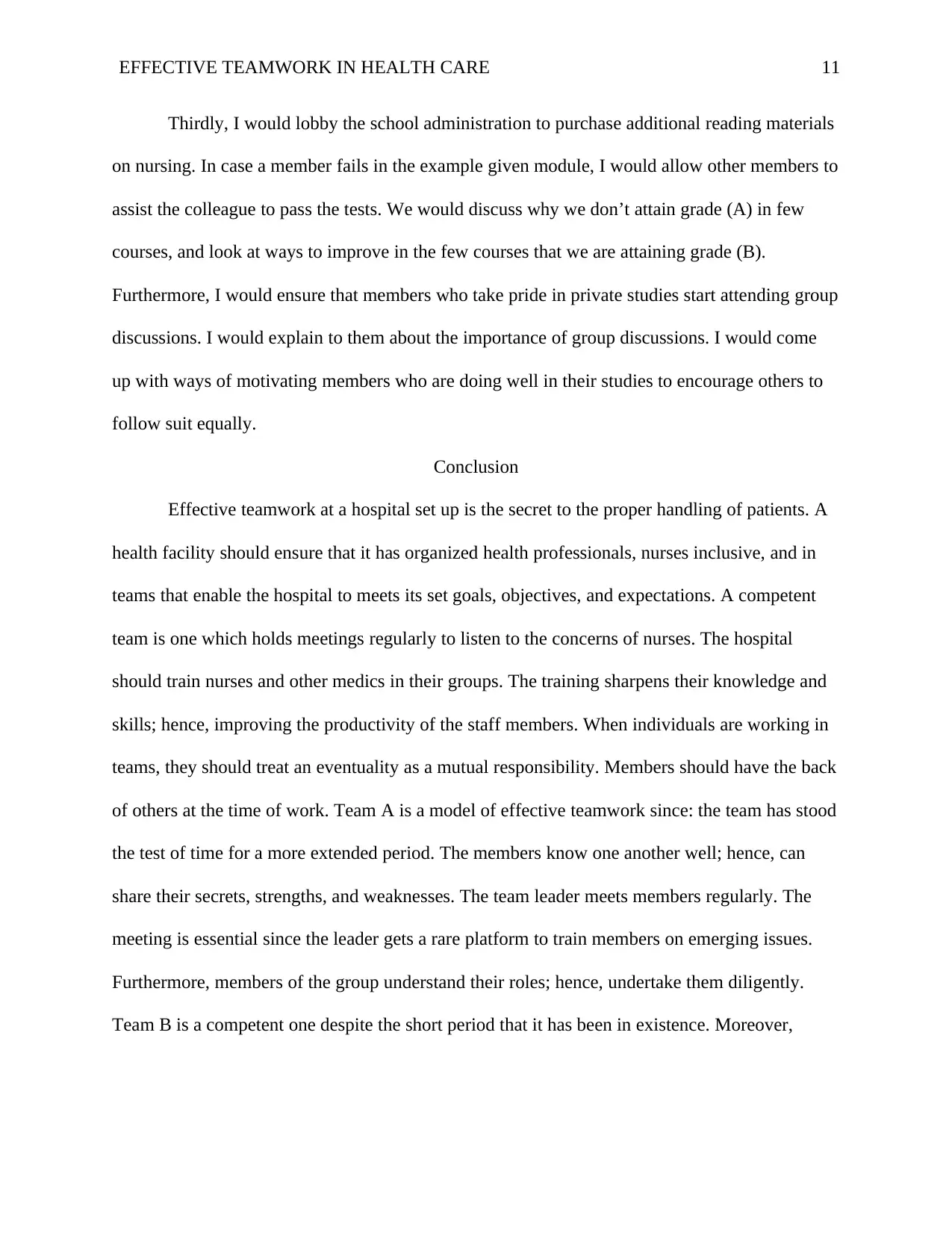
EFFECTIVE TEAMWORK IN HEALTH CARE 11
Thirdly, I would lobby the school administration to purchase additional reading materials
on nursing. In case a member fails in the example given module, I would allow other members to
assist the colleague to pass the tests. We would discuss why we don’t attain grade (A) in few
courses, and look at ways to improve in the few courses that we are attaining grade (B).
Furthermore, I would ensure that members who take pride in private studies start attending group
discussions. I would explain to them about the importance of group discussions. I would come
up with ways of motivating members who are doing well in their studies to encourage others to
follow suit equally.
Conclusion
Effective teamwork at a hospital set up is the secret to the proper handling of patients. A
health facility should ensure that it has organized health professionals, nurses inclusive, and in
teams that enable the hospital to meets its set goals, objectives, and expectations. A competent
team is one which holds meetings regularly to listen to the concerns of nurses. The hospital
should train nurses and other medics in their groups. The training sharpens their knowledge and
skills; hence, improving the productivity of the staff members. When individuals are working in
teams, they should treat an eventuality as a mutual responsibility. Members should have the back
of others at the time of work. Team A is a model of effective teamwork since: the team has stood
the test of time for a more extended period. The members know one another well; hence, can
share their secrets, strengths, and weaknesses. The team leader meets members regularly. The
meeting is essential since the leader gets a rare platform to train members on emerging issues.
Furthermore, members of the group understand their roles; hence, undertake them diligently.
Team B is a competent one despite the short period that it has been in existence. Moreover,
Thirdly, I would lobby the school administration to purchase additional reading materials
on nursing. In case a member fails in the example given module, I would allow other members to
assist the colleague to pass the tests. We would discuss why we don’t attain grade (A) in few
courses, and look at ways to improve in the few courses that we are attaining grade (B).
Furthermore, I would ensure that members who take pride in private studies start attending group
discussions. I would explain to them about the importance of group discussions. I would come
up with ways of motivating members who are doing well in their studies to encourage others to
follow suit equally.
Conclusion
Effective teamwork at a hospital set up is the secret to the proper handling of patients. A
health facility should ensure that it has organized health professionals, nurses inclusive, and in
teams that enable the hospital to meets its set goals, objectives, and expectations. A competent
team is one which holds meetings regularly to listen to the concerns of nurses. The hospital
should train nurses and other medics in their groups. The training sharpens their knowledge and
skills; hence, improving the productivity of the staff members. When individuals are working in
teams, they should treat an eventuality as a mutual responsibility. Members should have the back
of others at the time of work. Team A is a model of effective teamwork since: the team has stood
the test of time for a more extended period. The members know one another well; hence, can
share their secrets, strengths, and weaknesses. The team leader meets members regularly. The
meeting is essential since the leader gets a rare platform to train members on emerging issues.
Furthermore, members of the group understand their roles; hence, undertake them diligently.
Team B is a competent one despite the short period that it has been in existence. Moreover,
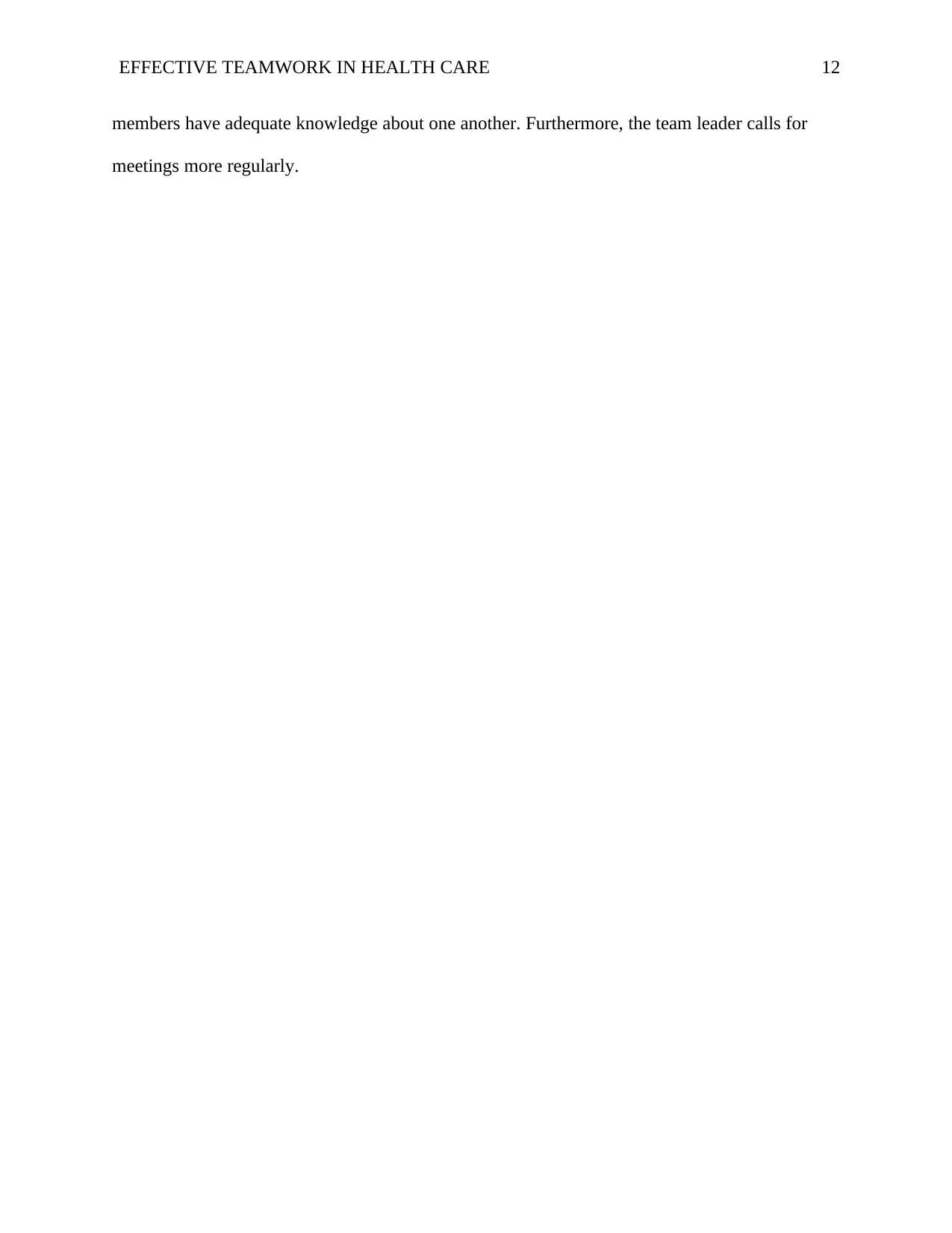
EFFECTIVE TEAMWORK IN HEALTH CARE 12
members have adequate knowledge about one another. Furthermore, the team leader calls for
meetings more regularly.
members have adequate knowledge about one another. Furthermore, the team leader calls for
meetings more regularly.
⊘ This is a preview!⊘
Do you want full access?
Subscribe today to unlock all pages.

Trusted by 1+ million students worldwide
1 out of 15
Related Documents
Your All-in-One AI-Powered Toolkit for Academic Success.
+13062052269
info@desklib.com
Available 24*7 on WhatsApp / Email
![[object Object]](/_next/static/media/star-bottom.7253800d.svg)
Unlock your academic potential
Copyright © 2020–2025 A2Z Services. All Rights Reserved. Developed and managed by ZUCOL.




